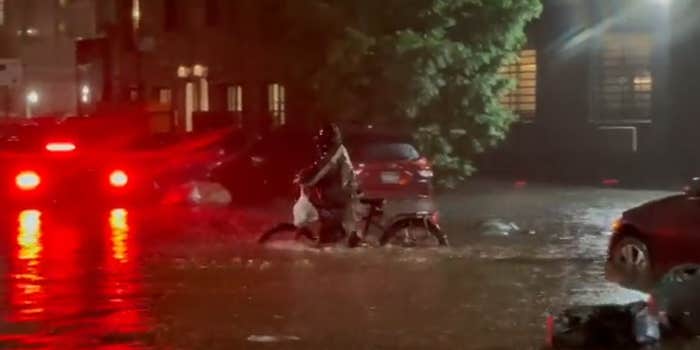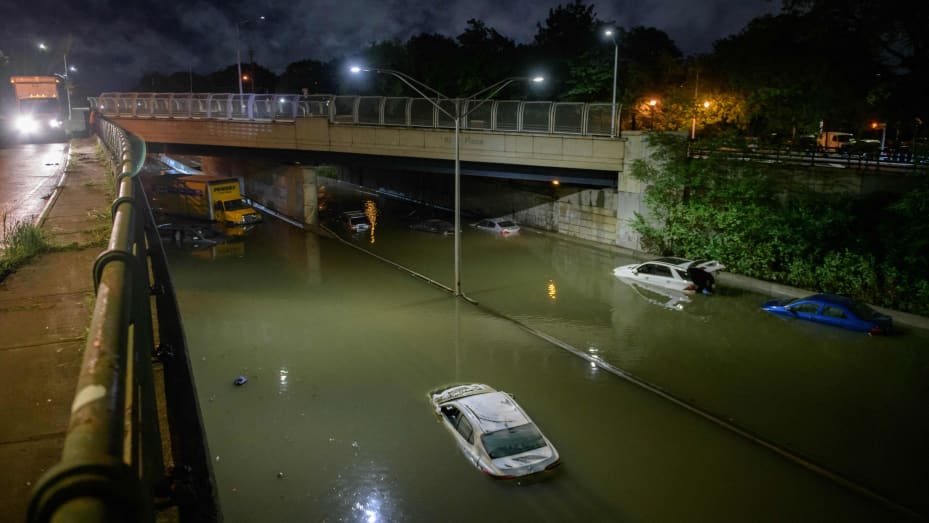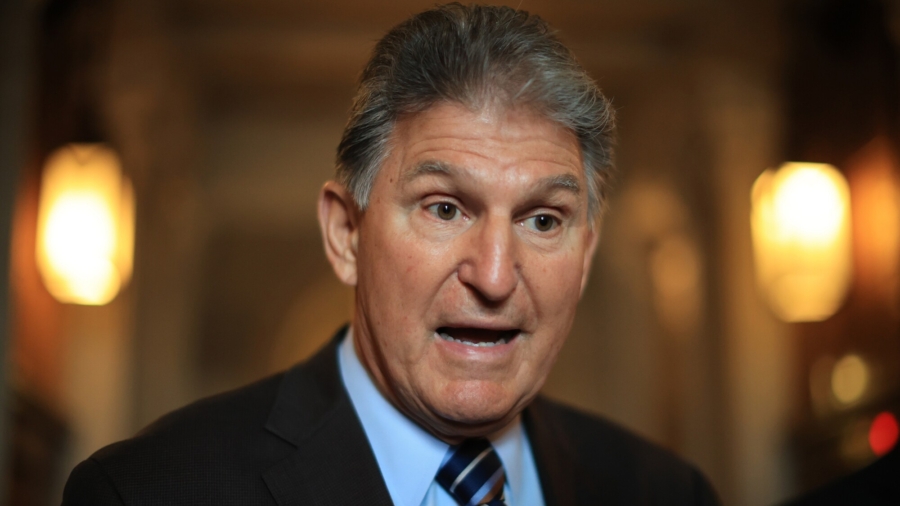Issued on: 03/09/2021 -
Text by: NEWS WIRES|
Video by: Jessica LE MASURIER
Flash flooding caused by the remnants of Hurricane Ida killed at least 41 people in the New York area overnight into Thursday, including several who perished in their basements during the "historic" weather event that officials blamed on climate change.
Record rainfall, which prompted an unprecedented flash flood emergency warning for New York City, turned streets into rivers and shut down subway services as water cascaded down platforms onto tracks.
"I'm 50 years old and I've never seen that much rain ever," said Metodija Mihajlov whose basement of his Manhattan restaurant was flooded with three inches of water.
"It was like living in the jungle, like tropical rain. Unbelievable. Everything is so strange this year," he told AFP.
Hundreds of flights were cancelled at LaGuardia and JFK airports, as well as at Newark, where video showed a terminal inundated by rainwater.
"We're all in this together. The nation is ready to help," President Joe Biden said ahead of a trip Friday to the southern state of Louisiana, where Ida earlier destroyed buildings and left more than a million homes without power.
Flooding closed major roads across New Jersey and New York boroughs including Manhattan, The Bronx and Queens, submerging cars and forcing the fire department to rescue hundreds of people.
At least 23 people died in New Jersey, Governor Phil Murphy told reporters.
"The majority of these deaths were individuals who got caught in their vehicles," he said.
Twelve died in New York City, including 11 who could not escape their basements, police said. The victims ranged from the ages of 2 to 86.
"Among the people MOST at risk during flash floods here are those living in off-the-books basement dwellings that don't meet the safety codes necessary to save lives," lawmaker Alexandria Ocasio-Cortez tweeted.
"These are working class, immigrant, and low-income people & families," she added.
Three also died in the New York suburb of Westchester while another three died in Montgomery County outside Philadelphia in Pennsylvania, a local official confirmed.
Ida blazed a trail of destruction north after slamming into Louisiana over the weekend, bringing severe flooding and tornadoes.
"We're enduring an historic weather event tonight with record-breaking rain across the city, brutal flooding and dangerous conditions on our roads," New York Mayor Bill de Blasio said late Wednesday.
State emergencies were declared in New York and New Jersey while the National Weather Service issued its first-ever emergency flash flood warning for New York City, urging residents to move to higher ground.
"You do not know how deep the water is and it is too dangerous," the New York branch of the National Weather Service (NWS) said in a tweet.
The NWS recorded 3.15 inches (80 millimetres) of rain in Central Park in just an hour -- beating a record set just last month during Storm Henri.
The US Open was also halted as howling wind and rain blew under the corners of the Louis Armstrong Stadium roof.
Lingering tornado threat
New Yorkers woke to clear blue skies Thursday as the city edged back to life but signs of the previous night's carnage weren't far away: residents moved fallen tree branches from roads as subway services slowly resumed.
Around 98,000 homes in Pennsylvania, 60,000 in New Jersey and 40,000 in New York were without power, according to the website poweroutage.us.
It is rare for such storms to strike America's northeastern seaboard and comes as the surface layer of oceans warms due to climate change.
The warming is causing cyclones to become more powerful and carry more water, posing an increasing threat to the world's coastal communities, scientists say.
"Global warming is upon us and it's going to get worse and worse and worse unless we do something about it," said Democratic senator Chuck Schumer.
In Annapolis, 30 miles (50 kilometers) from Washington, a tornado ripped up trees and toppled electricity poles.
The NWS warned the threat of tornadoes would linger, with tornado watches in effect for parts of southern Connecticut, northern New Jersey, and southern New York as Ida tracked north through New England Thursday.
(AFP)
Issued on: 02/09/2021 -

Text by: FRANCE 24
Video by: Jessica LE MASURIER
The governors of New York and New Jersey declared a state of emergency late on Wednesday as record-breaking rains from tropical storm Ida led to flooding and hazardous conditions on the roads, killing at least 26 people on the US East Coast.
"I am declaring a state of emergency to help New Yorkers affected by tonight's storm," New York Governor Kathy Hochul said on Twitter.
New York City Mayor Bill de Blasio described the flooding and weather on Wednesday night as a "historic weather event". The National Weather Service issued a flash flood emergency in New York City for the first time.
Nearly all New York City subway lines were suspended late on Wednesday as the remnants of Ida brought torrential rain and the threat of flash floods and tornadoes to parts of the northern mid-Atlantic, CNN reported earlier.
All non-emergency vehicles were banned from New York City's streets until 5am (9am GMT) on Thursday due to the weather, city authorities said on Twitter.
Earlier in the night, New Jersey Governor Phil Murphy also declared a state of emergency. He wrote on Twitter that 81,740 power outages were reported late on Wednesday.
A tornado swept through New Jersey's Gloucester County, damaging multiple homes, according to CNN affiliate WPVI.
All New Jersey Transit rail services apart from the Atlantic City Rail Line were suspended due to the extreme weather, the service said on its website.
Tornadoes spawned by the storm ripped through parts of Pennsylvania and New Jersey, images on social media showed.
New Jersey's Newark Liberty Airport said on Twitter it was experiencing "severe flooding". It said it resumed "limited flight operations" close to midnight after all flight activity was suspended late on Wednesday.
Social media images showed water gushing over New York City's subway platforms and trains. Subway service was "extremely limited" due to the flooding, the Metropolitan Transit Authority said.
First responders evacuated people from the subway system, the acting chair and CEO of the Metropolitan Transportation Authority, Janno Lieber, said in a statement.
De Blasio urged people to stay home.
"Please stay off the streets tonight and let our first responders and emergency services get their work done. If you're thinking of going outside, don't. Stay off the subways. Stay off the roads. Don't drive into these heavy waters. Stay inside," he wrote on Twitter.
(FRANCE 24 with REUTERS)

Gavia Baker-Whitelaw
Internet Culture
Published Sep 2, 2021
New York and New Jersey were hit by flash floods in the wake of Hurricane Ida on Wednesday night, with both state governors declaring a state of emergency. Footage from New York City is particularly shocking, showing flooded streets, subways, and apartment buildings—and inspiring comparisons to the disaster movie The Day After Tomorrow.
Released in 2004, The Day After Tomorrow depicts a heavily fictionalized image of climate change, where catastrophic weather devastates New York City in a matter of days. First comes a tsunami of floodwater, followed by a new ice age. As one of the quintessential NYC disaster movies, some of its scenes now look disturbingly similar to real life.
Some of the scenes from Wednesday night can best be described as apocalyptic, as people attempted to drive or wade through the flood waters. Mayor Bill de Blasio warned New Yorkers to stay inside due to “record breaking rain across the city, brutal flooding and dangerous conditions on our roads,” but many were still stranded while trying to brave the storm. Eight people have been reported dead so far, and there are widespread concerns about the dangers of walking through contaminated floodwater.
Over the past decade, NYC has experienced an influx of extreme weather, most famously with Hurricane Sandy in 2012. This February saw the heaviest snowfall in the city’s history, and another storm resulted in floods this July.
Hurricane Ida was particularly devastating, highlighting two interconnected problems: The city’s failing infrastructure and the increasingly obvious impact of climate change. New York’s subway system is notoriously in need of maintenance, but it was also never designed to withstand this level of flooding. So while The Day After Tomorrow may be a corny movie that played fast and loose with climate science, the comparisons are wholly understandable. On Wednesday night, New York really did look like a scene from a disaster movie.
Gavia Baker-Whitelawis a staff writer at the Daily Dot, covering geek culture and fandom. Specializing in sci-fi movies and superheroes, she also appears as a film and TV critic on BBC radio. Elsewhere, she co-hosts the pop culture podcast Overinvested. Follow her on Twitter: @Hello_Tailor
‘Nice dystopia you got there’: Grubhub worker spotted delivering food amid NYC floods sparks outrage
'Don't make people deliver food to you in weather like this. What the f*ck?'

@UnequalScenes/Twitter
Mikael Thalen
Internet Culture
Published Sep 2, 2021
An apparent Grubhub worker who was spotted wading through waist-high water to deliver food in New York City is stirring widespread debate on social media.
And through it all! @Grubhub delivery still out there bringing your dinner,” @UnequalScenes tweeted.
Many Twitter users responded to the clip, which has been seen more than 4.7 million times, by expressing outrage over the fact that someone had felt it necessary to order food.
“Hi folks, I promise you’ll be okay if you just make yourself a PB&J for the night,” @DatFirePrincess wrote. “Or even if you eat the peanut butter straight from the jar. Don’t make people deliver food to you in weather like this. What the fuck?”
“Shame on the person who made the order, and bigger shame on grubhub for accepting the order. The poor delivery person doesn’t deserve this,” another person added.
The viral video also led many to discuss the current state of the economy as well as poverty in modern day America.
“Forcing your way through dangerous floodwaters in the middle of a storm to deliver someone a burger is the reality of the poverty and precarity at the heart of the gig economy,” @bencsmoke added.
Countless users also began tagging Grubhub to demand that the company provide better conditions for their workers. The official Twitter account for Grubhub has not responded to the viral video. The Daily Dot reached out to Grubhub via email but did not immediately hear back.
“Deliveristas putting their lives at risk to deliver food in a tropical storm are the consequences of an unregulated gig economy,” @SamelysLopez said. “It’s inhumane.”
Hurricane Ida has led to at least 15 deaths across the region and produced record-breaking rainfall across New York. Yet gig workers, many who can’t afford to take time off, continue to face not only the coronavirus pandemic but devastating weather conditions as well.
Update 3:08pm CT: Grubhub told the Daily Dot they were looking into whether the person in the video is one of their drivers and said the safety of their employees is a priority for them.
Mikael Thalen is a tech and security reporter based in Seattle, covering social media, data breaches, hackers, and more.



 Sen. Joe Manchin (D-W.Va.) talks with reporters after stepping off the Senate Floor at the U.S. Capitol, in Washington, on May 28, 2021. (Chip Somodevilla/Getty Images)
Sen. Joe Manchin (D-W.Va.) talks with reporters after stepping off the Senate Floor at the U.S. Capitol, in Washington, on May 28, 2021. (Chip Somodevilla/Getty Images)
